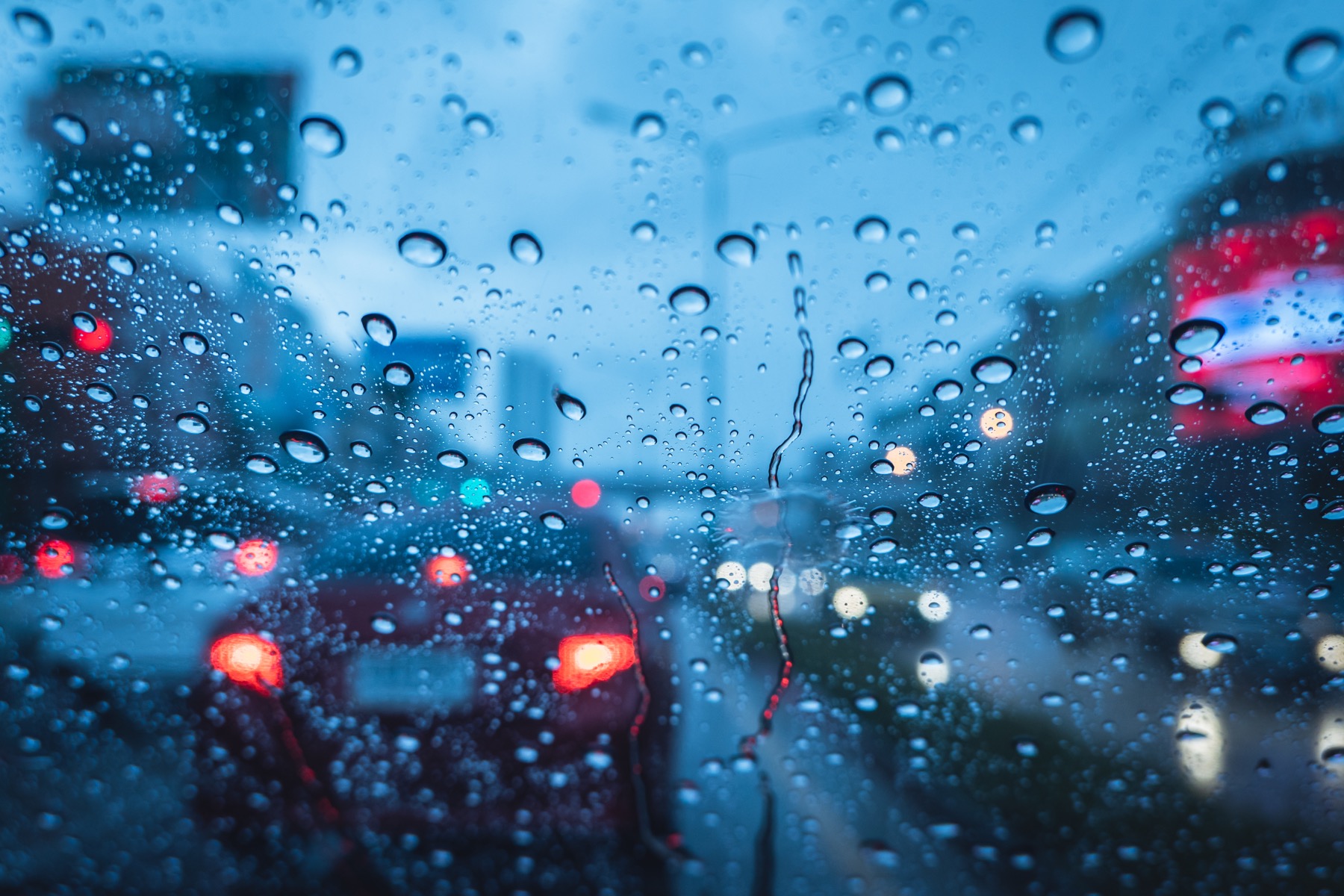Hurricane season in Houston is known for creating hazardous driving conditions. Unfortunately, not everyone will have the luxury of being able to stay at home. If you have to be on the road during hurricane season, be sure you know how to safely drive in the rain. Taking a few extra precautions will help you to avoid being involved in a car accident. Here are a few important tips to help you overcome the challenges of driving in the rain.
Rain Driving Tip #1: Drive Slower & Stay Alert
During hurricane conditions, drivers must always use extra caution. The road is often more slippery than you think. Aside from the rainwater, you also must factor in the oil and grease that drips from other vehicles. In certain spots, the pavement can feel like pure ice. This is why you should reduce your speed. Even if the posted speed limit is 55 mph, lowering your speed to 45 mph will give you more control. Driving in the slow lane also allows you more time to react to an oncoming road hazard.
Now is definitely not the time to relax your focus. Driving during heavy rain requires your complete attention. One-handed driving is an absolute no-no. Be sure to keep both hands on the wheel at all times. While sitting upright, your eyes should be constantly scanning the road ahead. Don’t try to do things like eating and streaming music from your phone. Of course, never make the mistake of trying to send out a text message. The consequences could be deadly. When you drive in the rain, distractions must be kept to a minimum.
Rain Driving Tip #2: Enhance Your Visibility
It’s no secret that rainy weather makes your windows more likely to become cloudy. Fortunately, most vehicles are designed with a defogger. After turning on your defogger, it shouldn’t take more than a few seconds for your windshield to start clearing up. If your defogger isn’t working, there are other ways to gain better visibility. In many instances, simply cracking your windows for a few minutes will get rid of the fogginess. This helps increase the humidity inside the vehicle.
Far too many drivers make the mistake of trying to clear foggy windows with their hands. This will only cause more problems. Not only will the fog quickly reappear, but your hands will also leave behind natural oils.
To further enhance visibility after dark, take the time to clean your headlights. It’s a simple procedure you can do right at home. After dampening a soft cloth, apply a few small daps of toothpaste to it. Next, firmly rub your headlights for around five minutes each. You can finish the job by removing the leftover residue with another clean rag.
Rain Driving Tip #3: Maintain a Safe Following Distance & Brake Effectively
Always stay a safe distance away from the next vehicle ahead. Every hurricane season, dozens of rear-end collisions are caused by drivers who were following too closely. Staying four car lengths behind the vehicle will help you to stay safe. Remember, slick conditions increase your vehicle’s stopping distance.
During an intense storm, never activate your vehicle’s cruise control system. You need to manually control the vehicle’s speed. Even the most sophisticated cruise control systems can’t adapt to the slick asphalt.
It’s just as important to know how to brake effectively. The best approach is to avoid heavy braking. This could cause you to lose control. Always try to brake early when approaching obstacles in the road. Letting off the accelerator ahead of time and driving in a low gear also enable you to take advantage of engine braking.
Be careful about getting behind large vehicles, including big trucks and buses. Their huge tires tend to spray large amounts of water. In some instances, you may not be able to see out of your windshield.
Rain Driving Tip #4: Watch Out for Standing Water
Standing water is dangerous. When driving over standing water at a relatively high speed, your vehicle could easily start to hydroplane. You’ll essentially be floating on water for a few seconds, thus giving you very little control. Even seemingly small puddles should be approached with caution. Remember, just a half-inch of water could cause your vehicle to lose complete traction. Upon seeing the reflection of standing water in the road, immediately start to reduce your speed. Try to drive in the tracks of the cars in front of you.
Here’s what to do if your vehicle does happen to hydroplane. Instead of abruptly slamming on the brakes, ease off the gas while keeping a tight grip on the steering wheel. Steering the vehicle in the direction that you want to go. If the vehicle is equipped with antilock brakes, press the pedal without letting up. Once you start to regain contact with the road, the vehicle should start to slow down.
Be extremely wary of standing water that is more than six inches deep. This is enough water to flood the exhaust of many cars, thus leaving them stranded in the road. Don’t hesitate to turn back. Never, ever attempt to drive through fast-moving water. The current can be strong enough to move an 18-wheeler with ease. Before crossing a bridge, make sure that it hasn’t started to flood. Rivers and creeks can become an unstoppable force of nature.
Rain Driving Tip #5: Keep Your Headlights On
Your headlights are critical during hurricane season. Aside from helping you to see at night, they also help make your vehicle more visible to other motorists. Although many modern vehicles feature LED daytime running lights, headlights are still more effective. In the state of Texas, the law requires drivers to turn on their headlights if visibility is less than 1,000 feet.
Contrary to what some drivers may believe, it’s not recommended to use high beams during heavy rain at night. The light could be reflected onto your face causing you to become temporarily blinded.
Rain Driving Tip #6: Try to Keep Children Safe & Calm
Driving through the rain is already a big enough challenge. However, an irritated child can create a more stressful atmosphere. The crying and screaming may take your concentration off the road. Parents need to make sure their children remain calm. While some kids like reading books, others prefer to play games on phones. Music can also help calm down a restless youngster.
If you have a child who is under 13 years old, keep them in the backseat. This will help protect them from the force of a deployed airbag. Furthermore, frontal impacts tend to be more common.
Rain Driving Tip #7: Know When to Pull Over
Even the most skilled drivers are often forced to pull over during a fierce storm. Intense rain creates extreme visibility issues. The high wind from a hurricane brings more danger. If you feel uncomfortable trying to remain on the road, find a safe location to park. Wait until the rain subsides before leaving again.
Rain Driving Tip #8: Prepare for a Long Traffic Delay
Hurricane season can cause a lot of traffic jams. Although many delays are a result of a collision, vehicle breakdowns are also common. On some highways, you could be stuck in traffic for literally hours at a time. Before leaving home, make sure you have enough fuel. The last thing you want is to give out of gas in the middle of a rainstorm. To be on the safe side, keep the tank at least half full at all times.
Rain Driving Tip #9: Replace Worn Out Components Ahead of Time
Before the hurricane season is in full effect, it’s a good idea to check your vehicle for potential problems. This is an easy way to help ensure a safe drive. For starters, you should inspect the condition of your tires. When driving on a rainy day, worn tires will make your vehicle far more prone to hydroplaning. You can use a basic penny test to check the tread depth of the tires. With Lincoln’s head pointed down, simply place the penny in between the grooves of each tire. If the top of Lincoln’s head is visible, this is a sign that it’s time to shop for a new set. Upgrading to better quality tires will give you extra peace of mind.
It’s just as important to check your windshield wipers for signs of damage. Ideally, you should replace your wiper blades once a year. Mother Nature’s elements can cause the rubber to gradually wear out. Many auto parts stores will install your new wiper blades for free. Also, don’t forget to make sure all of your exterior lights are working.
Make it a priority to have your vehicle fully serviced ahead of time. It’s an important aspect of hurricane preparedness. You never know what can happen. An intense storm may force officials to order an evacuation. Poorly maintained vehicles may not be able to handle an out-of-town trip. Getting a multi-point inspection will give you an extra sense of security. The service technicians will check the vehicle’s fluid levels and inspect for worn parts.

